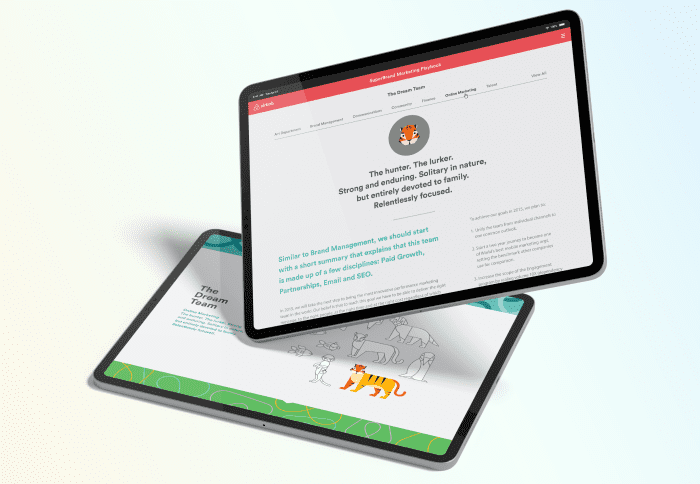
Mobile apps have become indispensable tools in the digital age, shaping our daily routines and interactions. Mobile is the first device a user tests everything in. However, creating a seamless user experience and an intuitive user interface in the constrained space of a mobile screen presents unique challenges.
One of the key challenges is creating a good user experience through a mobile UI UX design. Desktop and mobile app UX differ significantly due to distinct user behaviors, screen sizes, and interaction methods.
Let’s see how:
Screen size and layout
- Desktop: Larger screens allow for more expansive layouts, multiple windows, and complex interfaces. For instance, design software like Adobe Photoshop utilizes a multi-panel layout for various tools and options.
- Mobile: Limited screen space requires focused content. Apps like Instagram optimize for smaller screens, displaying a single-column feed with minimal distractions.
Interaction methods
- Desktop: Interaction involves precise mouse clicks, hover actions, and keyboard inputs. For instance, productivity apps like Microsoft Office rely on keyboard shortcuts and context menus.
- Mobile: Touch-based interactions dominate, using gestures like swipes, taps, and pinch-zoom. Messaging apps like WhatsApp incorporate swiping to navigate between chats.
Navigation and hierarchy
- Desktop: Desktop apps often have complex navigation menus, hierarchical structures, and multiple levels of navigation. Software suites like Adobe Creative Cloud utilize nested menus and toolbars.
- Mobile: Mobile apps prioritize more straightforward, more intuitive navigation. For instance, e-commerce apps like Amazon use tab bars or bottom navigation to quickly access primary sections.
Context and usage patterns
- Desktop: Often used in stationary settings conducive to focused work, allowing for prolonged usage. Software like video editing tools caters to longer sessions.
- Mobile: Used on the go or in various contexts, encouraging brief, frequent interactions. Maps apps like Google Maps prioritize quick access to navigation and local information.
Content presentation
- Desktop: Information-dense interfaces are common, enabling detailed data display simultaneously. Trading platforms like Bloomberg Terminal present extensive financial information.
- Mobile: Emphasis on streamlined content presentation to avoid clutter. Weather apps like Dark Sky highlight essential weather information in a concise format.
User expectations
- Desktop: Users might expect feature-rich interfaces with extensive customization options. For example, graphic design tools like Sketch offer numerous customization settings.
- Mobile: Users seek simplicity, speed, and immediate access to core functionalities. Social media apps like TikTok provide a straightforward, swappable feed of short videos.
Task completion and workflow
- Desktop: Often used for complex tasks or workflows requiring multitasking. Software such as project management tools like Asana caters to collaborative multitasking.
- Mobile: Focused on quick, single-task interactions. For instance, note-taking apps like Evernote emphasize quick note creation and retrieval.
Key strategies to put in practice
There are a lot of takers for a quality mobile app interface in this day and age. But they need to be effective to attract attention. To ensure a mobile app resonates with users and stands out in a crowded market, here are key strategies and pointers for crafting effective UI/UX designs tailored specifically for mobile platforms:
- Prioritize user-centric design
Embrace a user-centric approach by understanding your target audience’s needs, behaviors, and preferences. Conduct user research, interviews, and usability testing to gather insights that inform design decisions. Creating user personas helps in visualizing and catering to diverse user expectations.
- Simple and intuitive
Simplify the user journey by decluttering the interface. Prioritize essential features and information, employing a minimalist design ethos. Consistent navigation, clear hierarchy, and intuitive gestures enhance usability. Strive for intuitive interactions that feel natural to users.
- Responsive and adaptive design
Opt for a responsive design that adapts seamlessly to various screen sizes and orientations. Prioritize a fluid layout that adjusts elements proportionally. Ensure touch targets are adequately sized to accommodate different device sizes, avoiding accidental taps.
- Visual hierarchy and typography
Leverage visual hierarchy to guide users through the app. Use typography, color, and contrast to emphasize important elements. Employ readable fonts and appropriate text sizes for mobile screens, ensuring content remains legible across devices.
- Consistency across platforms
Maintain consistency in UI elements, branding, and interactions across different platforms. Users appreciate familiarity; hence, ensure a consistent experience between the mobile app and its web or desktop counterparts, if applicable.
- Loading speed and performance
Streamline the app’s performance by optimizing loading times and reducing unnecessary animations or heavy graphics. Prioritize swift interactions to prevent user frustration caused by sluggishness.
- Onboarding and user guidance
Design an effortless onboarding process that introduces users to key features while minimizing friction. Incorporate tooltips, walkthroughs, or interactive tutorials to guide users, helping them understand the app’s functionalities.
- Accessibility and inclusivity
Ensure your app is accessible to all users, considering aspects like color contrast, text size, and compatibility with screen readers. Implement accessibility standards to make your app usable by individuals with diverse abilities.
- Test, iterate, and refine
Continuous testing and iteration are crucial. Conduct usability tests, gather feedback, and analyze user behavior to identify pain points and areas for improvement. Iteratively refine the UI/UX based on these insights.
- Embrace trends mindfully
Stay updated with UI/UX trends, but implement them judiciously. Trends can enhance the app’s aesthetics and prioritize functionality and usability over fleeting design fads. Make sure you don’t fall into that trap!
Challenges and limitations
An effective mobile UI UX design has its own share of challenges. Designing for mobile apps presents a distinctive set of challenges due to the inherent limitations and unique user behaviors associated with mobile devices.
Some of the key challenges in mobile-specific UI/UX design include:
- Limited screen real estate
Mobile screens offer limited space compared to desktops, requiring designers to prioritize essential content and functionalities. Ensuring a seamless user experience within this confined space without compromising usability is a constant challenge.
- Diverse device fragmentation
The vast array of mobile devices with different screen sizes, resolutions, and operating systems presents a challenge in creating a consistent experience across devices. Designing for responsiveness and adaptability becomes crucial to accommodate this fragmentation.
- Touch-based interactions
Mobile devices rely primarily on touch interactions, introducing challenges in designing intuitive gestures and touch targets. Ensuring these interactions are easy to understand and execute across various user demographics can be challenging.
- Performance and loading speed
Mobile apps must load swiftly and operate seamlessly, considering varying network speeds and device capabilities. Balancing visual appeal with optimal performance becomes crucial to prevent user frustration caused by slow loading times.
- Contextual user behavior
Mobile usage often occurs in various contexts – on the go, in varying lighting conditions, and amidst distractions. Designing for these contexts requires consideration of one-handed use, readability in different environments, and quick task completion.
- Battery and data consumption
Apps that consume excessive battery power or data are often uninstalled. Designers need to optimize designs to minimize resource consumption while ensuring a rich user experience.
- Navigation and information architecture
Crafting intuitive navigation within limited space while maintaining a clear information hierarchy poses a challenge. Designers must create streamlined navigation paths that accommodate various user intents and preferences.
- Platform guidelines and standards
Adhering to platform-specific design guidelines (iOS, Android) while maintaining brand identity and consistency across platforms requires a delicate balance. Striking this balance is crucial for both aesthetics and usability.
- Accessibility considerations
Ensuring accessibility for users with disabilities on mobile devices can be challenging due to smaller screens and touch-based interactions. Designers must prioritize inclusive design practices to cater to diverse user needs.
- User engagement and retention
Mobile apps face fierce competition for user attention. Designing experiences that captivate users from the first interaction and retain their engagement over time is an ongoing challenge.
Addressing these challenges requires a deep understanding of user behaviors, continuous testing, and a commitment to iterative design improvements. Successful mobile UI/UX design involves balancing aesthetics, functionality, and usability within the constraints and opportunities of mobile devices.
Best practices in mobile UX design
In a world dominated by handheld devices, the success of a mobile app hinges not just on its functionality but also on the seamless and intuitive experience it offers. Crafting exceptional mobile UX involves an intricate balance of design, functionality, and empathy towards user needs. These experiences must transcend the limitations of compact screens and varied contexts in which mobile devices are used.
Amidst this challenge lies a spectrum of best practices that form the cornerstone of effective mobile UX design. From intuitive navigation and simplified onboarding to responsive layouts and inclusive accessibility features, these practices elevate mobile app experiences, making them usable and delightful for users.
- Intuitive navigation
Instagram’s bottom tab bar allows users to navigate easily between home feed, search, reels, shop, and profile without digging through menus. It offers clear icons and labels for effortless navigation.
- Responsive design
The Guardian app adjusts its layout dynamically based on screen size and orientation, ensuring a seamless reading experience whether on a smartphone or tablet.
- Simplified onboarding
Duolingo’s interactive tutorial introduces users to the app’s features while teaching a new language. It’s a seamless blend of onboarding and learning, making the initial experience engaging and informative.
- Clear CTAs
The Airbnb app employs prominent and descriptive CTAs, guiding users through the booking process with clear buttons that specify actions like “Book Now” or “Contact Host.”
- Gestural design
Tinder’s swipe feature for liking or disliking profiles utilizes a simple gesture that aligns with natural user behavior, making the app interactive and enjoyable.
- Consistent visual language
Google’s Material Design ensures consistency across its suite of apps, utilizing common UI elements, icons, and animations. This uniformity fosters familiarity and ease of use.
- Content prioritization
The BBC News app uses card-based layouts, enabling users to quickly scan headlines and summaries. It prioritizes content based on relevance and user preferences for a personalized experience.
- Feedback and confirmation
When sending a message on WhatsApp, the double checkmarks that turn blue upon message delivery provide users with visual feedback, assuring them that their message has been successfully sent and received.
- Minimized user input
Apple Pay simplifies the checkout process by minimizing user input. Users can complete purchases quickly using stored payment and shipping information, reducing friction in the transaction.
- Accessibility features
VoiceOver in iOS assists visually impaired users by describing elements on the screen. Apps like BlindSquare use this feature to provide navigation assistance based on audio cues.
Implementing these best practices creates a cohesive, engaging, and user-friendly mobile experience. Tailoring design elements to match user behaviors and preferences while focusing on simplicity and functionality enhances the overall mobile UX.
Case studies
- Headspace
Headspace wanted to make meditation and mindfulness accessible to users. The app features a calming color scheme, clear navigation, and guided meditation sessions. It simplifies a complex topic into manageable, user-friendly sessions. Headspace’s mobile UX garnered a loyal user base, exceeding 70 million downloads. Its serene design contributes to users’ comfort and relaxation.
- Uber
Uber aimed to revolutionize the ride-hailing experience. The app employs location services, minimalistic design, and a straightforward booking process. Its real-time tracking and transparent pricing enhance user confidence. Uber’s mobile UX disrupted the transportation industry. Its simplicity and ease of use contributed to its widespread adoption and global success.
- Calm
Calm sought to offer a comprehensive meditation and sleep aid app. The app’s serene visuals, soothing sounds, and guided meditation paths create a tranquil user experience. Its simple interface and personalized recommendations tailor content to individual preferences. Calm’s UX contributed to its recognition as Apple’s App of the Year. Its user-friendly design helped it secure millions of subscribers seeking mental wellness.
- Nike Training Club (NTC)
NTC aimed to provide a comprehensive fitness app for users of varying fitness levels. The app offers personalized workout plans, instructional videos, and progress tracking. Its clean design and intuitive interface simplify the workout routine customization process. NTC’s user-centric approach increased engagement, solidifying its position as a leading fitness app with millions of downloads.
Each case study exemplifies how exceptional mobile UX design, encompassing simplicity, personalization, and ease of use, contributes to these apps’ success and widespread adoption in their respective domains.
FAQs
- What is the difference between UI and UX design?
UI focuses on an app’s visual elements and layout, while UX encompasses the overall feel and usability. UI deals with the look and feel, while UX involves the user’s journey and interaction with the app.
- Why is responsive design important in mobile UX?
Responsive design ensures an app adapts seamlessly to different screen sizes and orientations, providing a consistent experience across devices. It’s crucial for accommodating the diverse range of mobile devices users may employ. Pepper Square has put together more on this in one of our blogs A Guide to Mobile App UI Designs.
- How do you prioritize features in mobile app design?
Prioritizing features involves understanding user needs through research and feedback. Essential features that align with user goals should take precedence, ensuring a streamlined and focused user experience.
- What are the key principles of mobile UX design?
Some key principles include simplicity, intuitive navigation, clear hierarchy, responsive design, consistency, accessibility, and continuous iteration based on user feedback and behavior analysis.
- How do you optimize mobile app performance without compromising UX?
Optimizing performance involves reducing unnecessary animations, compressing images, caching data, and minimizing server requests. Prioritizing essential functionalities and streamlining code contribute to improved performance without sacrificing UX.
- Why is user testing important in mobile UX design?
User testing involves gathering feedback from real users to identify pain points, usability issues, and preferences. It helps refine the app’s design, ensuring it meets user expectations and enhances overall usability.
- How can accessibility be integrated into mobile UX design?
Accessibility can be integrated by using readable fonts, providing sufficient color contrast, ensuring touch targets are appropriately sized, incorporating screen reader compatibility, and adhering to accessibility standards like WCAG.
- What are some common mobile UX design mistakes to avoid?
Common mistakes include overcrowded interfaces, inconsistent navigation, ignoring responsive design, neglecting user feedback, overlooking accessibility considerations, and implementing overly complex interactions.
- How can mobile app design contribute to user retention?
Engaging UX, personalized experiences, seamless onboarding, intuitive navigation, quick task completion, and continuous updates based on user feedback contribute to user satisfaction and long-term retention.
- How do you balance aesthetics with functionality in mobile UI design?
Balancing aesthetics and functionality involves prioritizing usability over excessive ornamentation. Utilize visual hierarchy, intuitive interactions, and consistent design elements to create a visually appealing yet functional interface.
Effective UI/UX design for mobile apps demands a harmonious blend of creativity, empathy, and technical prowess. By prioritizing user needs, embracing simplicity, and iterating based on feedback, designers can create mobile experiences that captivate users and stand the test of time. Remember, successful mobile app design isn’t just about aesthetics; it’s about crafting experiences that users find delightful, intuitive, and indispensable in their daily lives.








